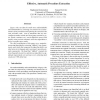ICSE
1995
IEEE-ACM
14 years 6 months ago
1995
IEEE-ACM
— Reverse engineering of large legacy software systems generally cannot meet its objectives because it cannot be cost-effective. There are two main reasons for this. First, it is...
ECOOPW
1998
Springer
14 years 7 months ago
1998
Springer
In restructuring legacy code it may be useful to introduce a design pattern in order to add clarity to the system and thus facilitate further program evolution. We show that aspec...
SC
2000
ACM
14 years 7 months ago
2000
ACM
This paper describes a Wrapper Generator for wrapping high performance legacy codes as Java/CORBA components for use in a distributed component-based problemsolving environment. U...
IWPC
2003
IEEE
14 years 8 months ago
2003
IEEE
Legacy code can often be made more understandable and maintainable by extracting out selected sets of statements to form procedures and replacing the extracted code with procedure...
OOPSLA
2004
Springer
14 years 8 months ago
2004
Springer
Generics offer significant software engineering benefits since they provide code reuse without compromising type safety. Thus generics will be added to the Java language in the...
ICCSA
2004
Springer
14 years 8 months ago
2004
Springer
Abstract. This paper describes an architecture for publishing and executing parallel legacy code using an OGSI Grid service. A framework is presented that aids existing legacy appl...
GRID
2004
Springer
14 years 8 months ago
2004
Springer
One of the biggest obstacles in the wide-spread industrial take-up of Grid technology is the existence of a large amount of legacy code that is not accessible as Grid services. Th...
SIGOPSE
2004
ACM
14 years 8 months ago
2004
ACM
Implementing an extension of a legacy operating system requires knowing what functionalities the extension should provide and how the extension should be integrated with the legac...



